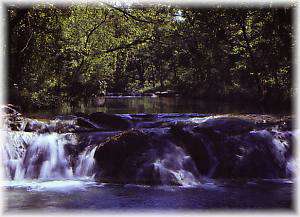Chickasaw National Recreation Area
category : Recreation
 "Peaceful Valley of Rippling Waters"
"Peaceful Valley of Rippling Waters"This statement was used to describe this area's significance by early American Indian inhabitants as long as 7,000 years ago. These beautiful words can still be used today to describe Chickasaw National Recreation Area and its many resources. From prehistoric times to the present, access to the combination of cool water, mineral springs, cool breezes, shade, and wildlife has created at Chickasaw National Recreation Area an experience that sets it apart from the surrounding environment.
Springs, streams and lakes are the attractions at Chickasaw National Recreation Area, the first national park in the state of Oklahoma. This area is known as a special family park, offering a variety of activities all year. Its streams and lakes cater to boaters, swimmers and fishermen, while its forests and prairies reward hikers, wildlife photographers and campers. The Travertine Information and Nature Center and its adjacent environmental study area offer a glimpse of our natural world through exhibits, nature walks and other educational programs. Chickasaw National Recreation Area is one of the most heavily visited parks for its size in the National Park System, with 3.4 million visitors a year.
In 1902, 640 acres of Chickasaw tribal land was transferred to the United States government and given the name of Sulphur Springs Reservation. In 1906, the area was renamed Platt National Park in honor of Senator Orville Hitchcock Platt. During the 1930s, the Civilian Conservation Cops built pavilions and roads, laid out trails, engineered waterfalls, and planted half a million trees and shrubs. In 1976, Platt National Park was combined with Arbuckle Recreation Area and additional lands to create a new national recreation area in honor of the land's longtime inhabitants: the Chickasaws.
The springs and streams of Chickasaw come from one of the most complex geological and hydrological features in the United States. These resources have been economically and environmentally significant throughout the history of the region, and are valuable for scientific research.
Dating from the public works era of the 1930's, classic examples of Civilian Conservation Corps (CCC) architectural craftsmanship and ingenuity--included in one of the largest and most intact designed cultural landscapes of that period--blend harmoniously with the natural environment. A trail system was designed and constructed during this period that meets the needs of the casual walker as well as the avid exerciser.
The park holds within its boundaries a vast diversity of natural resources. These unique flora, fauna, waters, and geological formations have withstood the external pressures of man-made and natural changes. The combination of these resources has created an area unlike any in the surrounding territory. Chickasaw lies in a transition zone where the Eastern deciduous forest and the Western prairies meet. It has flora and fauna from both environments, and other flora and fauna specific to such transition areas. The view over Veterans Lake, especially beautiful at sunset, illustrates this transition.
TRAILS - Bromide Hill Trail provides hikers with a rewarding view. Buffalo Trail offers the chance to see a herd of American bison. Trails follow Travertine Creek and Rock Creek, leading to many springs. Rock Creek Multi-Use Trail (unpaved) is a network of hiking, biking, and horse trails that pass through a variety of ecosystems. Bicycles and pets are prohibited on trails east of Travertine Nature Center.
SPRINGS - The abundant waters of the Buffalo and Antelope springs form Travertine Creek. Black Sulphur, Pavilion, and Hillside springs, along with Vendome Well, produce mineral water. The park neither substantiates no denies claims about the medicinal value of the water.Campground
CAMPGROUNDS - All campgrounds have tables, grills, restrooms, and water. Camp in designated campsites only. Limited electrical hookups and showers are available at Buckhorn and The Point campgrounds. Maximum length of stay is two weeks.
NATURE CENTER - The Travertine Nature Center offers the chance to experience nature up close. Exhibits include live birds, fish, reptiles, and amphibians. Ranger-led activities are offered.
Admission: Free Admission
Hours: Summer - Daily, 8:00 AM to 9:00 PM
Winter - Daily, 8:00 AM to 5:00 PM
Closed Christmas Day and New Years Day
Address: South of Sulphur on US 177, 2 miles East of Park Headquarters
Phone: 580-622-3165
Our Website:www.nps.gov/chic
 The peak season is from Memorial Day to Labor Day with activities focusing on water recreation and camping. Lowest visitation occurs during the months of January and February.
The peak season is from Memorial Day to Labor Day with activities focusing on water recreation and camping. Lowest visitation occurs during the months of January and February.
Come visit us in Oklahoma, Oklahoma